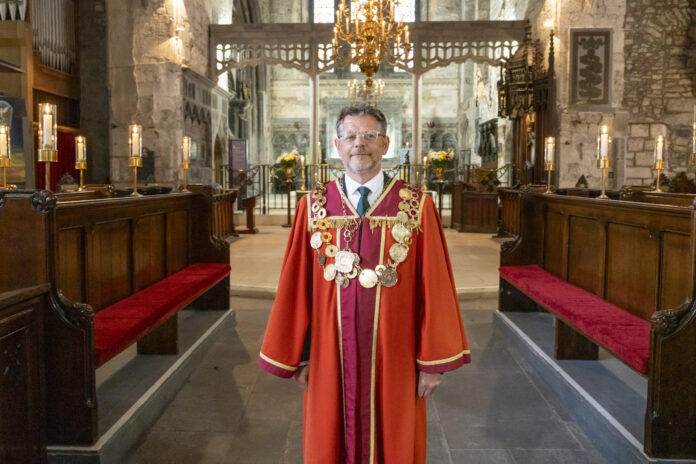
NEXT week Limerick’s first directly-elected mayor will bring a draft of his masterplan for the mayoral term before the 40 members of the local authority – a plan that, he cautiously admits in the document itself, “might not be easily achieved”.
In the opening page of the ambitious 105-page document, Mayor John Moran also admits that to bring his vision to reality will require Limerick to get its fair share of funding from national government.
Moran maintains that what is set out in his mayoral plan is what he considers the best path to creating a new Limerick – one that reflects the views of all the communities and people he has consulted along the way.
“We will all need to work together to pull the various levers to achieve this. I strongly believe over the next five years we can do much to set solid foundations so that others who follow in my footsteps can complete the work we are now beginning and indeed add further to the work we will have completed,” he wrote in the draft plan.
Moran envisions a Limerick in which O’Connell Street and Georgian Limerick can be a “globally recognised” tourist destinations boasting sports, shopping, museums, and dining.
In Moran’s future Limerick, a total of 50,000 new residents will be comfortably accommodated by 2040. Though this, he concedes, can only be done by ensuing compact growth and community viability.
His main aspirations include more amenities and improved public transport for county towns and villages, better road safety, increased Garda resources, investment in neglected buildings, and making areas in South East Limerick – such as Lough Gur, Kilmallock, and Ballyhoura – a tourist destination to rival any other.
A home focus
Social exclusion is another issue Moran wants to see tackled, believing that to create more opportunities and transform vulnerable areas, the Limerick Regeneration project must continue to receive necessary funding from the Government.
Limerick’s pioneering first citizen wants to use top-down planning and investment to deliver pathways for regeneration to better integrate vulnerable areas. His draft plan suggests the need to scale amenities to serve a “broader hinterland and encourage participation from the widest community possible” while still locating them in regeneration areas in an effort to “break down existing barriers, real or perceived”.
Moran, who owns 23 properties in Ireland and the US, recently reported in The Ditch as bringing in €300,000 in annual rent, wrote that he wants to have a credible plan underway by 2029 to see a real step up delivery of long-term affordable housing options in Limerick.
The property magnate, charging up to €1,400 a month for a single room in his city co-living development on The Crescent, hopes to explore the creation of a Limerick-specific Approved Housing Body (AHB) – something he considers the first step in a move toward a “Vienna” model of housing on Shannonside.
The Mayor insists the Vienna model would “enable the ownership and control by Limerick of much greater numbers of public housing”. And the investment in such, he says, “will deliver a dividend once financings are paid off for future generations. It will also allow City Hall to alleviate pressure on tenants in the rental market both in terms of rent levels and security of tenure.”
Changing how we view living in Limerick City, Moran reveals, is another priority, as well as the publication of standards/rules for historical buildings and public realm in the Georgian quarter, in which he owns a number of properties.
“We need to see better living options for apartment living and compact growth in Limerick. This includes prioritisation of amenities and outdoor spaces for people without private gardens. It means making sure public transport routes and vehicular routes crossing the city do not make public realm completely unattractive for residents and for neighbourhood retail,” the report reads.
Manifesto manifest
Moran also aspires to see Abbeyfeale transformed to create a “Limerick Town of the Future” and deliver much-needed investment into Kilmallock.
Ultimately, the extensive mayoral roadmap for the next five years aims to build a Limerick that is “more liveable, more prosperous, and more healthy” – a confirmation that he is aiming to make manifest the many points in his mayoral manifesto during the busy election season.
The Mayor also vowed to be accessible and present across all communities and available for questioning, saying he will “make it a priority to continue to make myself available as I can for the media and communities groups”.
“Sometimes that will involve just casually visiting communities all over the city and county and walk the streets and roads of Limerick. Other times, I shall do media interviews or shows permitting questions to be posed from the general public,” he wrote.
Moran says he is committed to ensuring that every corner of the city and county thrives through equitable development, robust infrastructure, and amenities to deliver a better quality of life.
On Monday next (August 26), Moran will deliver his draft plan to the members of Limerick City and County Council at a special meeting in County Hall, Dooradoyle, for their thoughts on his vision of the future.
However, as the meeting is not a statutory one, plans cannot be passed on the day. Mayor Moran will have to wait until the next full local authority meeting in September, at the earliest, before his plans can get approval from Council members. In the meantime, he will be looking to take the feedback of the elected representatives on the draft programme before finalising the final document in the coming months.


